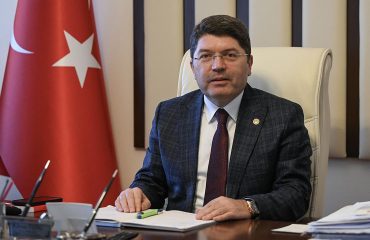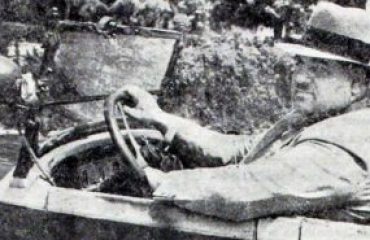
Speaking at the Parliament Planning and Budget Commission on the evening of November 18, Foreign Minister Mevlüt Çavuşoğlu said that the operation that resulted in the death of ISIS leader Baghdadi had been made possible by intelligence gathered from a high-ranking ISIS member who was caught in Turkey. Earlier that day, Iraq’s military intelligence chief Lieutenant General Saad al-Allaq said in an interview with CNN that nine ISIS members, including two of their “best” bombers, had fled to Turkey and their files had been passed onto Turkish officials.
According to Allaq, these Iraqi citizen bombers are Khair Allah Fatthi, born in Slahaddin 1977 and Hussein Ferhan al-Jumaili, born in Ambar in 1981. Both had fled from Iraq because of anti-ISIS operations to Syria, cut deals with smugglers in the (YPG/PKK dominated) SDF controlled areas by handing out bribes in YPG/PKK-controlled areas and made their ways into Turkey, near Gaziantep. The Iraqi intelligence officer claimed that the group of terrorist, including some of their finance people controlling sums of money, have been planning large-scale attacks, also by helping ISIS members escape from prisons. CNN reported that the Turkish authorities whom they asked were “looking into the claims”.
Such timing was noteworthy. Çavuşoğlu was on his way to Brussels on November 19 to attend the NATO Foreign Ministers meeting on November 20. He was expected to hold a series of meetings there, including one with U.S. Secretary of State Mike Pompeo. He was then scheduled to go to the G20 Foreign Ministers meeting in Nagoya, Japan, scheduled on November 22-23.
Meanwhile, Çavuşoğlu said at the parliament that neither the U.S. nor Russia have been keeping their promises about clearing the border area from YPG/PKK militants and Turkey could resume the halted “Peace Spring” military operation into Syria if the situation goes on like this. Russia said that such a move would “increase tension in Syria”. This was followed by a statement from Turkish Defence Minister Hulusi Akar, saying that Turkey is working together with Russia to solve the issues and a statement by Russian Foreign Minister Sergei Lavrov who said that they got assurances from Turkey that the operation would not be resumed.
So, what was going on? To understand better, we need to rewind the tape a bit.
A man called al-Ithawi
When Çavuşoğlu said that Baghdadi’s location information was obtained from another high-ranking ISIS member, he was referring to Ismail al-Ithawi. Ithawi was captured on 8 February 2018 in the Serdivan district of Turkey’s Sakarya province, Western Turkey, some 100 km East of Istanbul, following a “two-month-long” chase in a joint operation by the Turkish police and MIT, Turkey’s National Intelligence Organization. It was the Iraqi National Intelligence Service (INIS) who had informed MIT that Ithawi had fled to Turkey at the end of 2017 and actually was a joint operation by Iraqi and Turkish intelligence agencies.
Ithawi had been known as the number 5 in the ISIS organization when he was captured. Responsible for the group’s finances and issuing of fatwas, religious edicts, and he was one of the highest-level ISIS members that have been captured alive. Known inside the organization by the code name “Abu Zeyd al-Iraqi”, Ithawi, born in Ramadi, in 1963, was turned over to Iraqi authorities on 14 February 2018 after having been interrogated for 6 days in Turkey. He was then interrogated by both Iraqi intelligence and the American CIA and was sentenced to the death by hanging on September 19 2018. No further information about him surfaced to the public after that.
The blog “Deep State”, that publishes content regarding intelligence, wrote that using the Telegram app on Ithawi’s cell phone, which was captured by Turkish intelligence, Iraqi intelligence lured four more ISIS members that had been responsible for the group’s finances into Iraq and arrested them. That same blog stated that after the CIA and Iraqi intelligence interrogated Ithawi and his deputies, many bank accounts and secret communication codes were uncovered. The Voice of America radio said that the “information obtained from the ISIS commander captured by Turkey proved vital” in locating Baghdadi. Blogger Tom Stevenson wrote that crucial information on Baghdadi’s daily routine had been unearthed during interrogations. With the help of this information, and the capture of ISIS member Abu Suleiman al-Khalidi by the Hayat Tahrir al-Sham -an ex-Al Qaeda offshoot having alleged ties with Turkey-backed groups in Syria- and his subsequent interrogation, Americans were able to establish that Baghdadi was located at Barisha, Syria, near the Turkish border where the operation was carried out on October 26.
Coincidences and questions
The first mention of Ithawi’s capture in Turkey was almost lost between the lines when Turkish press reported that 42 alleged ISIS members were captured during operations by the police in Istanbul, Bursa, Konya and Mersin. According to the information given to media, they were preparing attacks during the October 29 Republic Day celebrations. It was only a line in the reports that, in the meantime, Ithawi had been caught earlier as a top ISIS operative. However, in international media reports, Ithawi’s name was highlighted as most of the suspects caught were alleged members of the financial organization of ISIS. These statements made it to the news on October 30, four days after October 26 when it was reported that Baghdadi committed suicide during an operation carried out by the U.S.
Back then, Turkish President Tayyip Erdoğan reacted to U.S. President Donald Trump because he thanked “Syrian Kurds” alongside Iraq, Turkey, Russia and Syria, for their help with the operation. Erdoğan announced on November 6 the capture of Baghdadi’s wife Asma al-Kubaisi by saying “We captured his wife but didn’t make a big deal of it.” The following day, the German news agency DPA wrote, citing Turkish authorities that Kubaisi was in fact captured in June 2018 in the Syria border province of Hatay, along with 10 ISIS members. This date overlaps with the period where Ithawi was being interrogated by Iraq and the U.S.
Was the intelligence that led to the capture of Kubaisi and ISIS members by the Turkish police obtained during these interrogations and conveyed to Turkey? Why was the capture announced after the Baghdadi operation? Those questions have no answers yet by Turkish authorities.
There are more questions. For instance, questions on the death of the ex-British army special operations officer James Edward Le Mesurier, whose body was found in front of his house in Istanbul on November 11 morning. He was known to be the founder of the “White Helmets” which has been denouncing human rights violations in Syria since 2013, the year when ISIS was also founded. Le Mesurier had been accused by the Russians of being a British intelligence MI6 agent working in the balks and the Middle East: the claim was denied by the British government. Did the case have anything to do with anti-ISIS operations? Turkish authorities are still working on the Le Mesurier case to find out whether he committed suicide by jumping off his balcony or a murder.
Yet the most important questions are those: Did ISIS bombers really flee to Turkey as claimed by Iraqi intelligence? Are the ISIS members who are responsible for bloody terrorist attacks in Turkey, including the October 10, 2015, Ankara massacre, killing 105 and wounding 500 among us? Are they still in Turkey? Have they been caught already? Are they among the ISIS members Turkish Interior Minister Süleyman Soylu said were on their way to be sent back to their countries?
Don’t we have the right to expect answers about those questions?
* Translated into English by Aras Zarakol.


